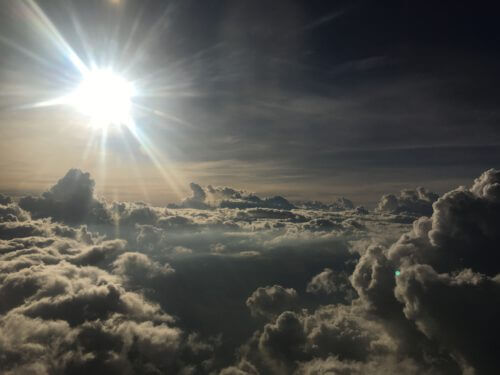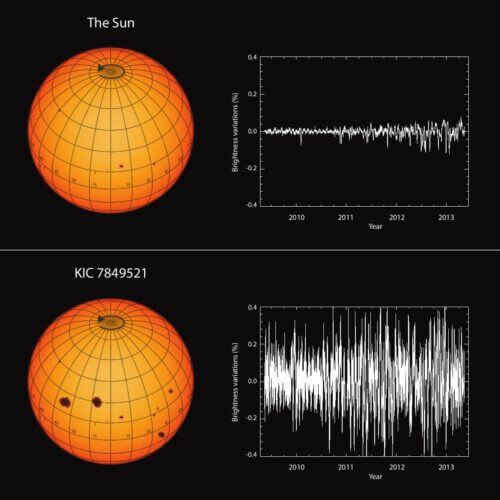Research shows that the Sun is less active than "sibling" stars (of similar mass and similar age) - here's what it could mean
By Andrew Norton, Professor of Astrophysics Education, UK Open University

All stars emit varying amounts of light over time—and the Sun is no exception. These changes in starlight can help us understand how habitable any planets around other stars are – a very active star can bombard its planets with harmful radiation. Now a new study, published in Science, shows that the Sun is significantly less active than other, similar stars.
In many stars, the observed variation in brightness is caused by their internal magnetic field. When parts of the genetic field burst out through the front of the star, it can result in dark areas called starspots or brighter areas (called paculae) in the star's atmosphere. As a star rotates on its axis, the bright and dark regions pass through the surface of the star from our point of view, causing a cyclical change in the star's brightness as a result.
Some of the most extreme examples of variable stars are eclipsing binary stars and pulsating stars. In the first case the light variation is due to an external influence: a pair of stars orbiting their common center of mass repeatedly hides some of their partner's light from our point of view. If you observe a straight path in front of the rim line (edge-on), the brightness of the star will appear to decrease significantly at regular intervals.
In a pulsating star, the changing light has an internal reason: the star literally pulsates in and out, getting bigger and then smaller, brighter and then fainter, with a regular pattern of changing brightness. The brightness of pulsars can vary by a factor of ten or more each cycle. Both of these types of stars are favorite targets for astronomers because their light variations can be used to study the dynamics or structure of star systems.
The quiet before the storm?
But the magnitude of the brightness variation of stars due to bright and dark spots moving through our line of sight is usually much smaller. The sun's brightness changes by only a fraction of a percent as it rotates every 24 days. Even such small changes can affect Earth's climate on timescales of decades or the chemistry of its atmosphere on timescales as short as months or days.
We have records of sunspots from 1610, and they show that the sun regularly goes through a cycle every 11 years where the number of intermittent sunspots reaches a maximum and then they almost completely disappear. When the sunspots are at their maximum, the sun is especially active - bursts of light called solar flares and mass ejections from the sun are more common. They can have a big impact on our lives here on Earth. In addition to causing the Northern Lights, they can also disrupt satellites and damage power lines.
In the new study, the researchers compared a 140-year record of the Sun's brightness with the light curves of a group of sister suns obtained from observations by the Kepler satellite over four years. They looked at stars whose temperature, mass, radius and age are all similar to the Sun, and selected 349 stars whose rotation period was measured between 20 and 30 days.
The astronomers measured a range of variability from 0 (no change in brightness) to 0.75%, with an average around 0.36%. By taking random four-year segments from the Sun's light curve, they found that the typical variation of the Sun's brightness was only 0.07%—and the maximum value was no more than 0.20% either. They therefore concluded that most stars of the same type as the Sun are more active than the Sun.

MPS / hormesdesign.de
The brightness variation of the Sun compared to the star KIC 7849521.
MPS / hormesdesign.de
So does this mean that the sun is really different from other stars of the same type? Astronomers know that as stars age their rotation slows down and they become less magnetically active. At some point they may move into a new phase of very little activity - but we don't know exactly when this change occurs. Perhaps the sun is approaching this stage in its life. Alternatively, perhaps the reason is simply that in the 140 years of solar data they used, they sampled only a relatively quiet period of solar activity - perhaps it was more active at other times?
This possibility is more worrying. This may mean that the sun can go through periods where its variability is much greater, with a corresponding increase in magnetic activity and stronger emissions that can disrupt life here on earth.
Perhaps there is some comfort in the fact that measurements of certain isotopes - variants of chemical elements with heavier or lighter nuclei - on Earth can be used to track the activity of the sun over the past 9000 years. They find that the variation of the sun's brightness has not changed significantly in this timeline either.
Understanding the variability of stars is essential to assessing the extent to which extrasolar planets are habitable. In extreme cases, stellar eruptions can remove the atmosphere from an otherwise habitable star. The recently discovered planet orbiting the nearest star, Proxima Centauri b, for example, is in the habitable zone of its star, but Proxima Centauri itself is a very active star and the planet is probably being bathed in harmful radiation from stellar eruptions.
This new research may indicate that only very inactive stars like the Sun are likely to have habitable planets. Perhaps we should be thankful that the sun is among the calmest of its brothers.
For an article in The Conversation
More of the topic in Hayadan:

9 תגובות
You have to ask God to change batteries for the sun. She unloads in the middle of us all the time.
I agree with anonymous anonymous... it is well known that they spray. Haven't you noticed that every day there is a father's horizon? Did you know that mercury is sprayed? Why???
Where is this aging hot yeeeeee
Anonymous (unidentified) user
What are you doing on a smart people site?
Hila
The judgment is not only based on observations, but based on theories. We observe the phenomena, develop explanations for the observations - and most importantly - check if the conclusions of our explanations are correct.
For example: the explanation of the big bang predicted that radiation of a certain frequency would be seen at a certain distance - and indeed such radiation was discovered.
Nothing gets old, endlessly sprayed by countless jet planes, white clouds to hide the sunlight... climate engineering
Some fake news in the articles.
Haven't you seen a white sky?
Didn't you see that the sun is hidden on purpose?
And who are we to judge the sun based on 140 years of observation? We are a speck of dust in the universe. You have to look at the big picture.
So in another million years there will be no Mediterranean Sea and in another billion years we will have to look for another planet. All this if we survive.
DNA molecules are built so that in their space they survive at almost any cost. At the price of quenching entropy outside in their limited space, they make sure that entropy increases. In the event that a planet is destroyed, the DNA can possibly pass to another planet through the rocks, but only as the lowest form of life.
Perhaps the activity of the sun played a part in dispersing the atmosphere of Mars